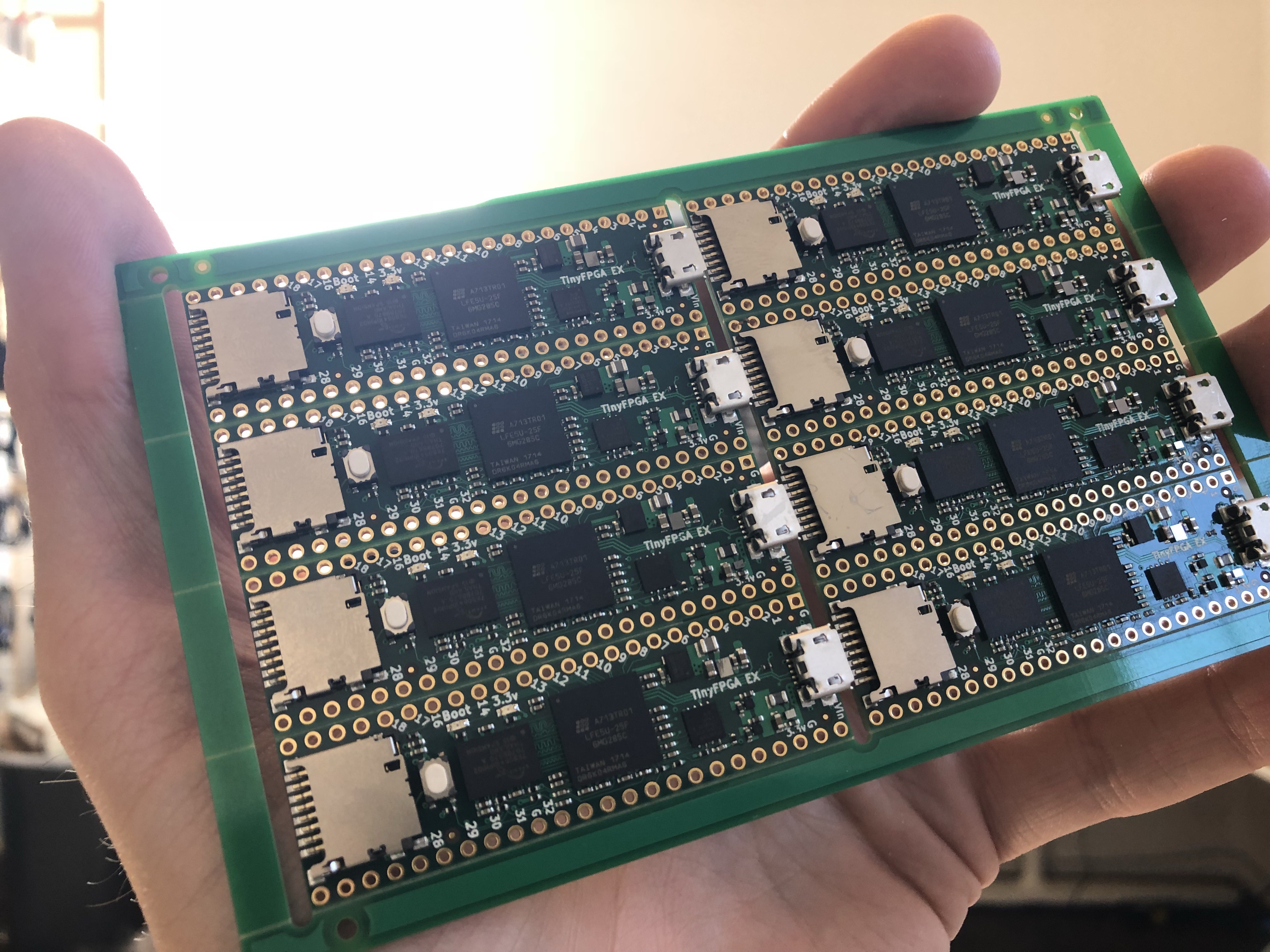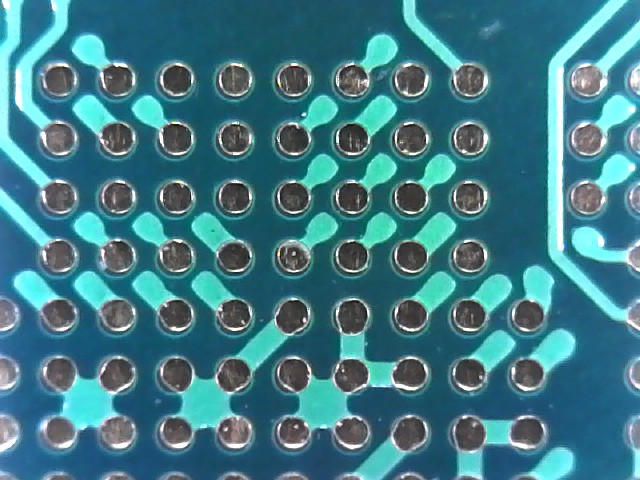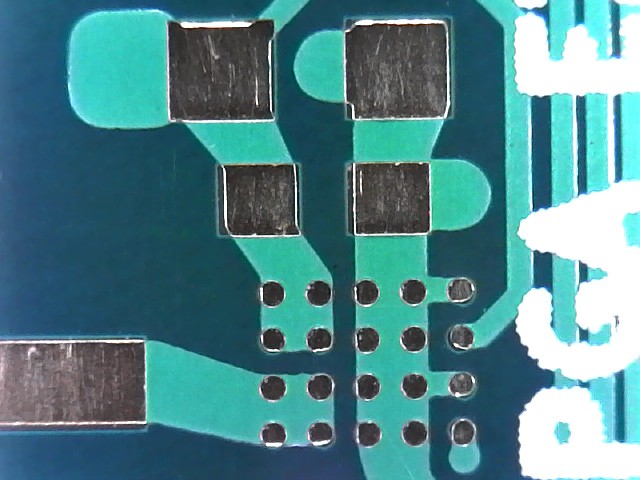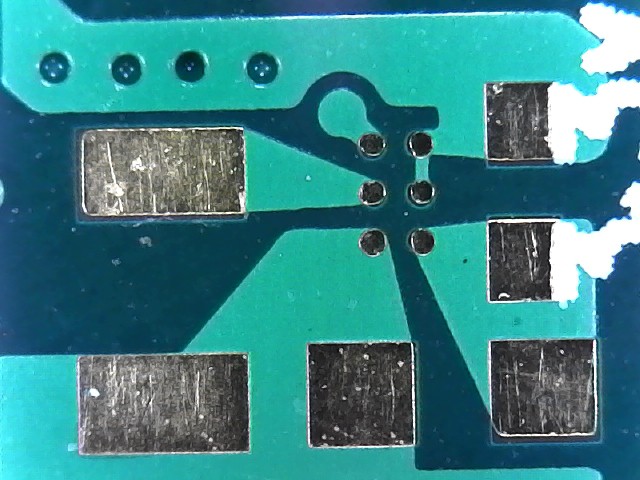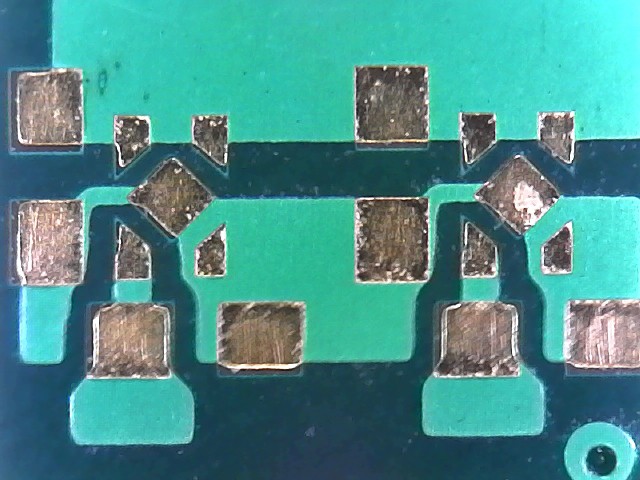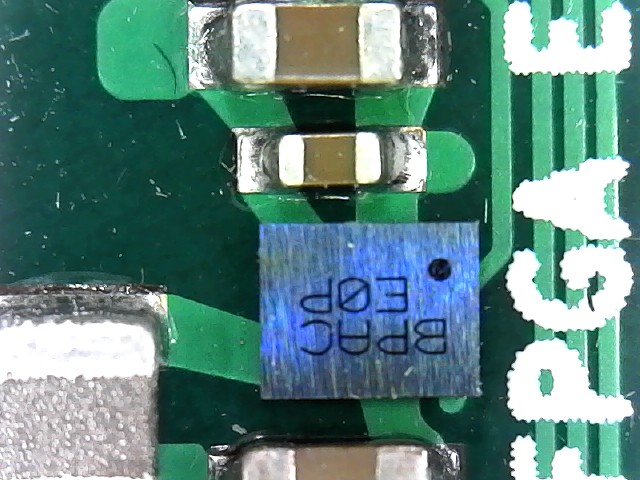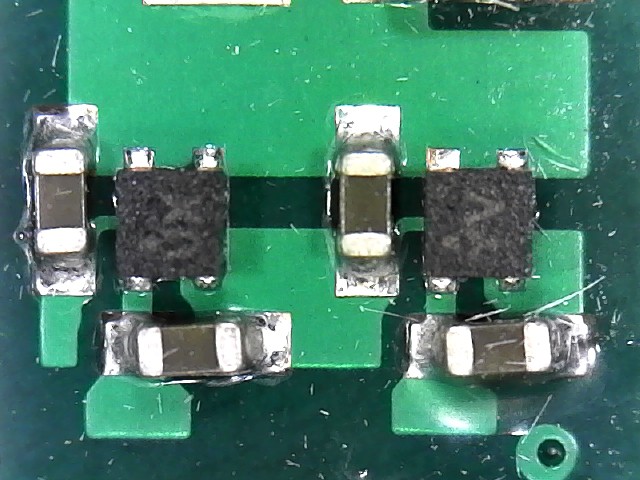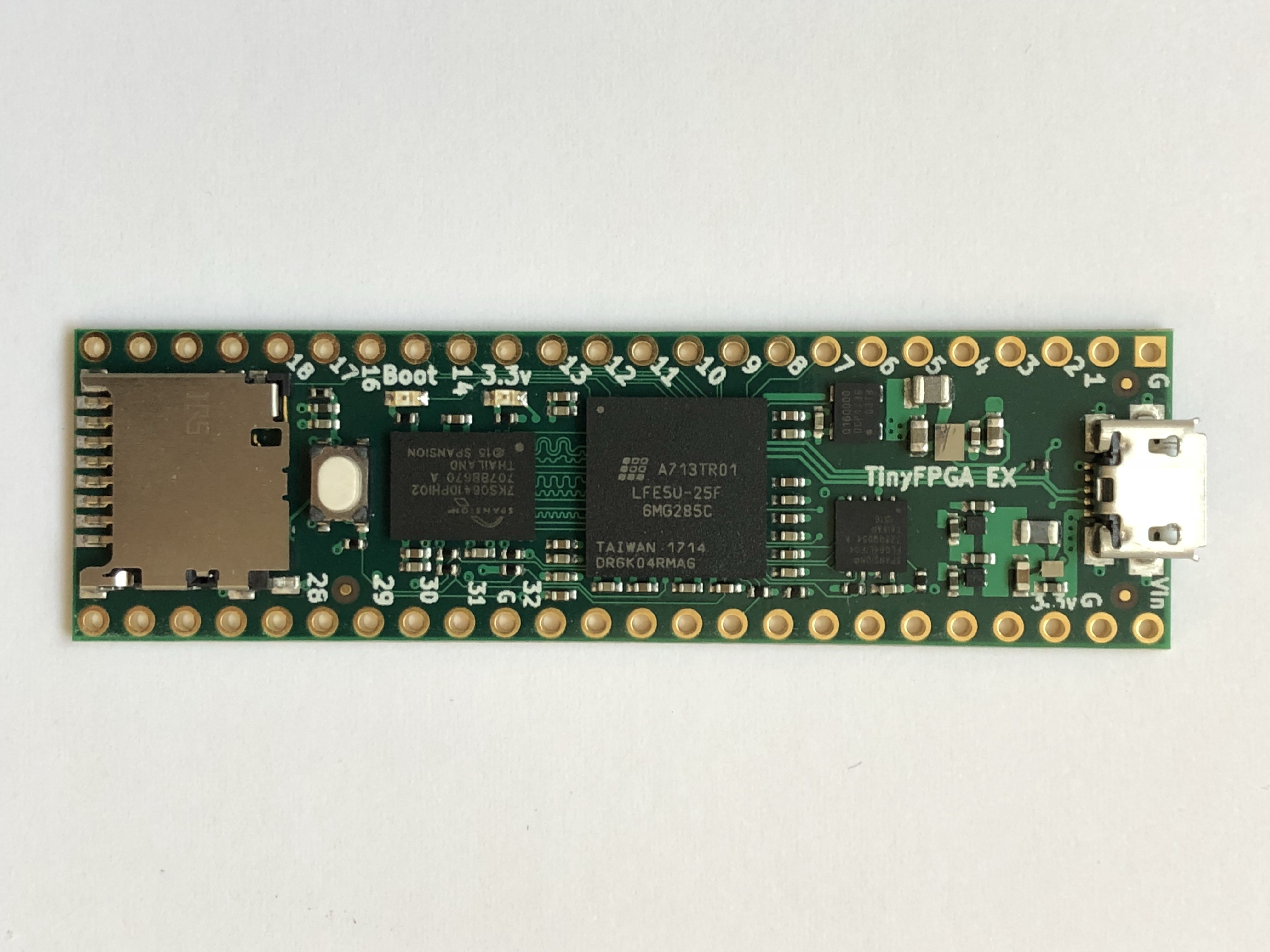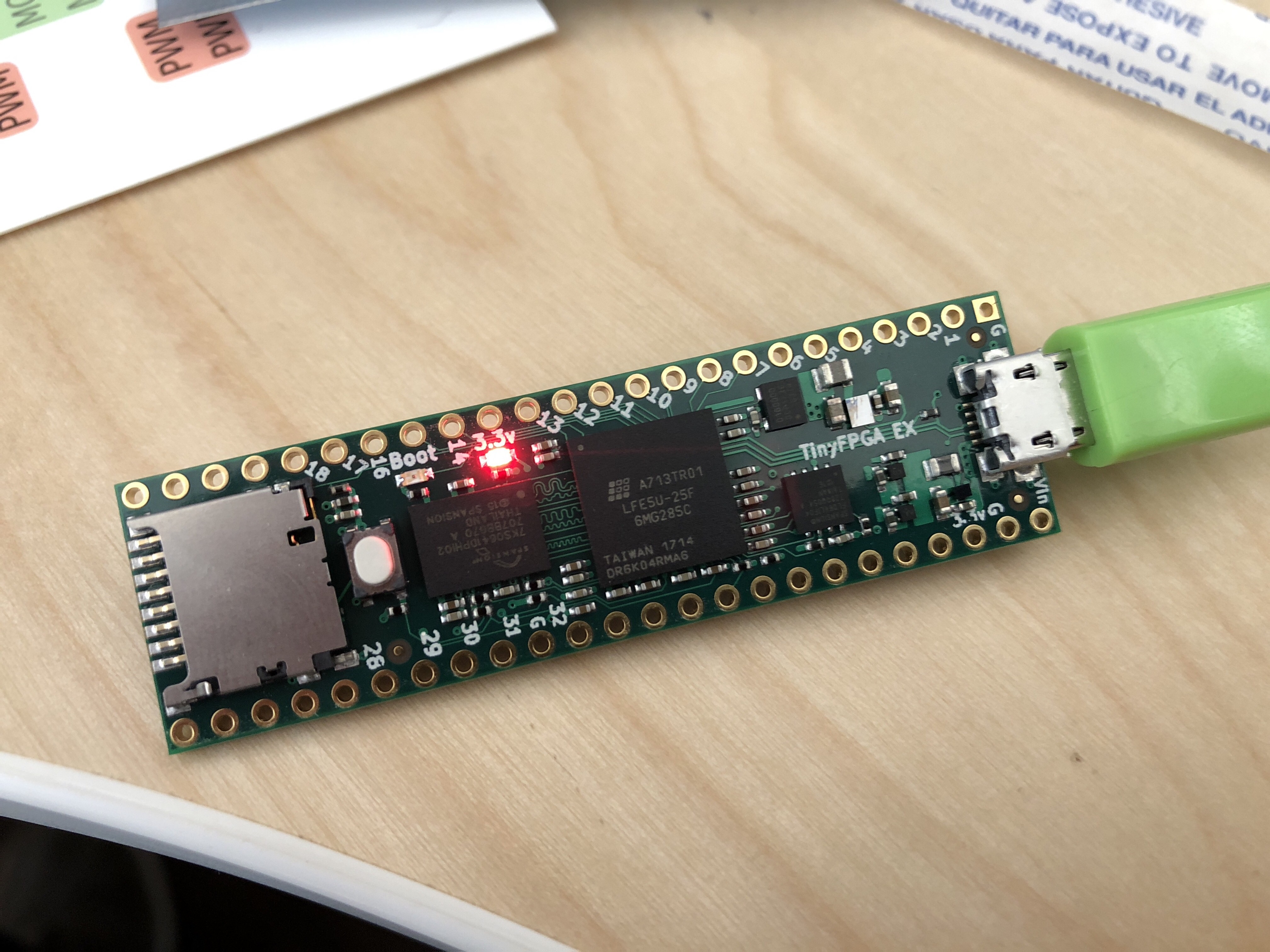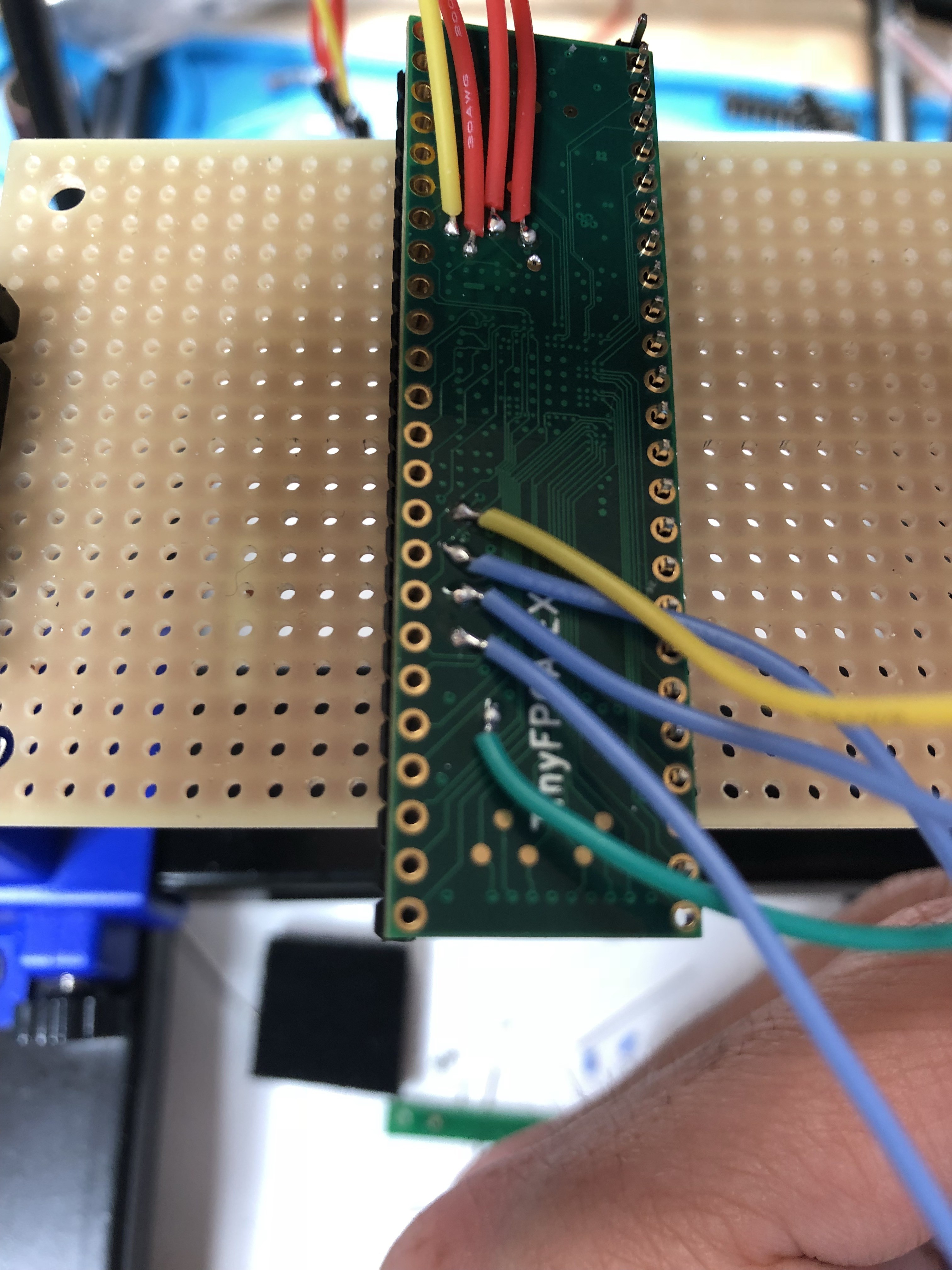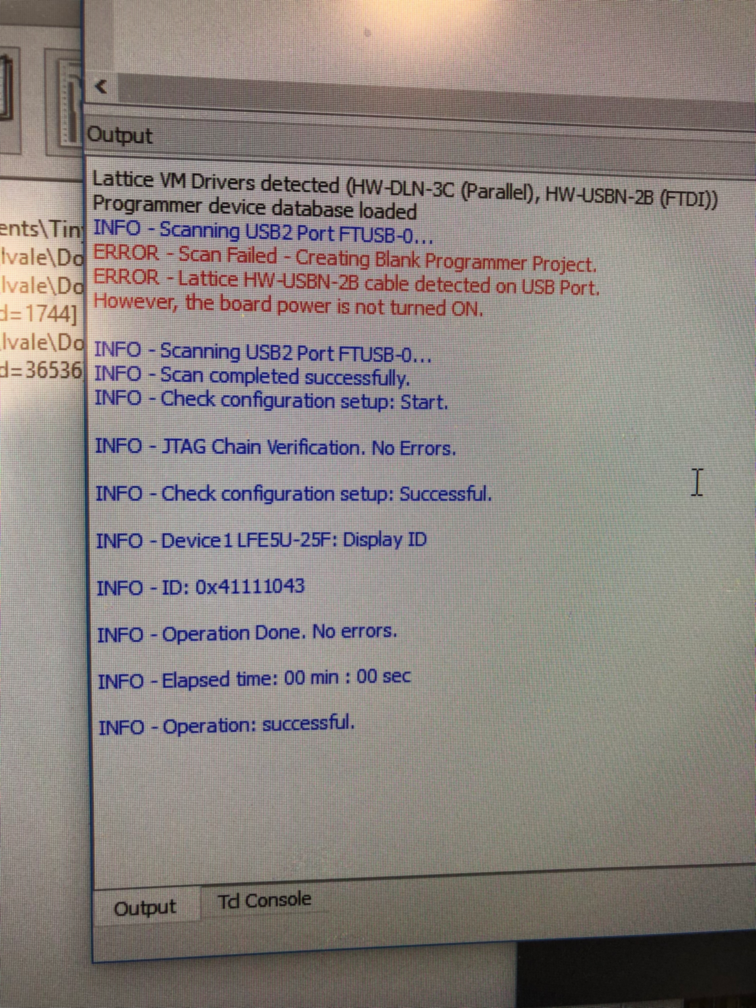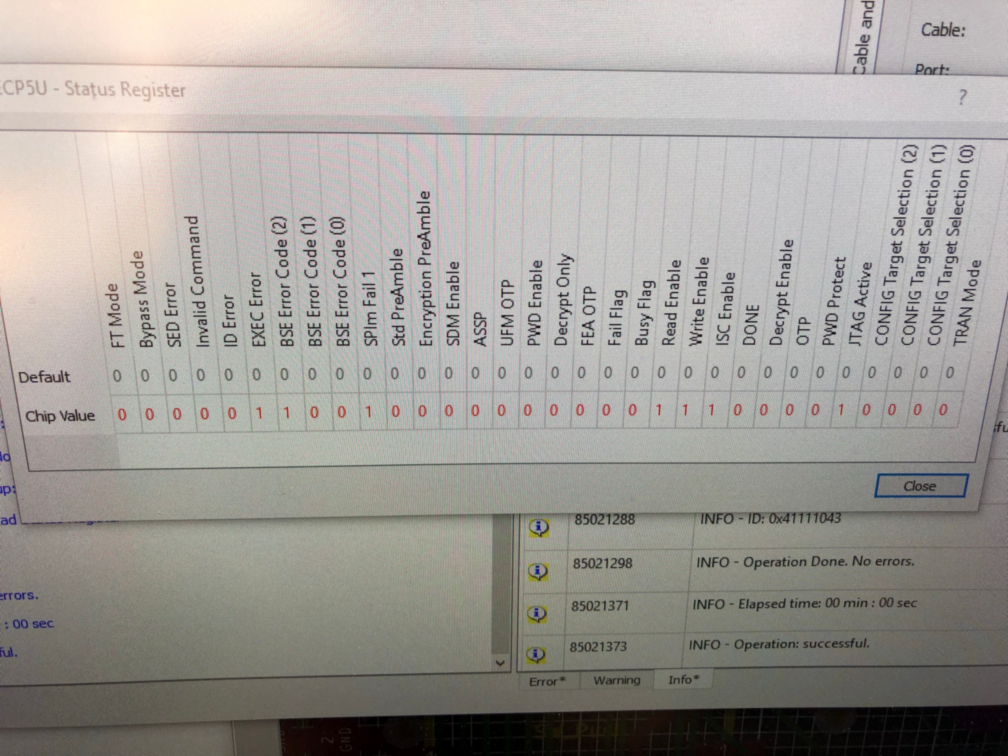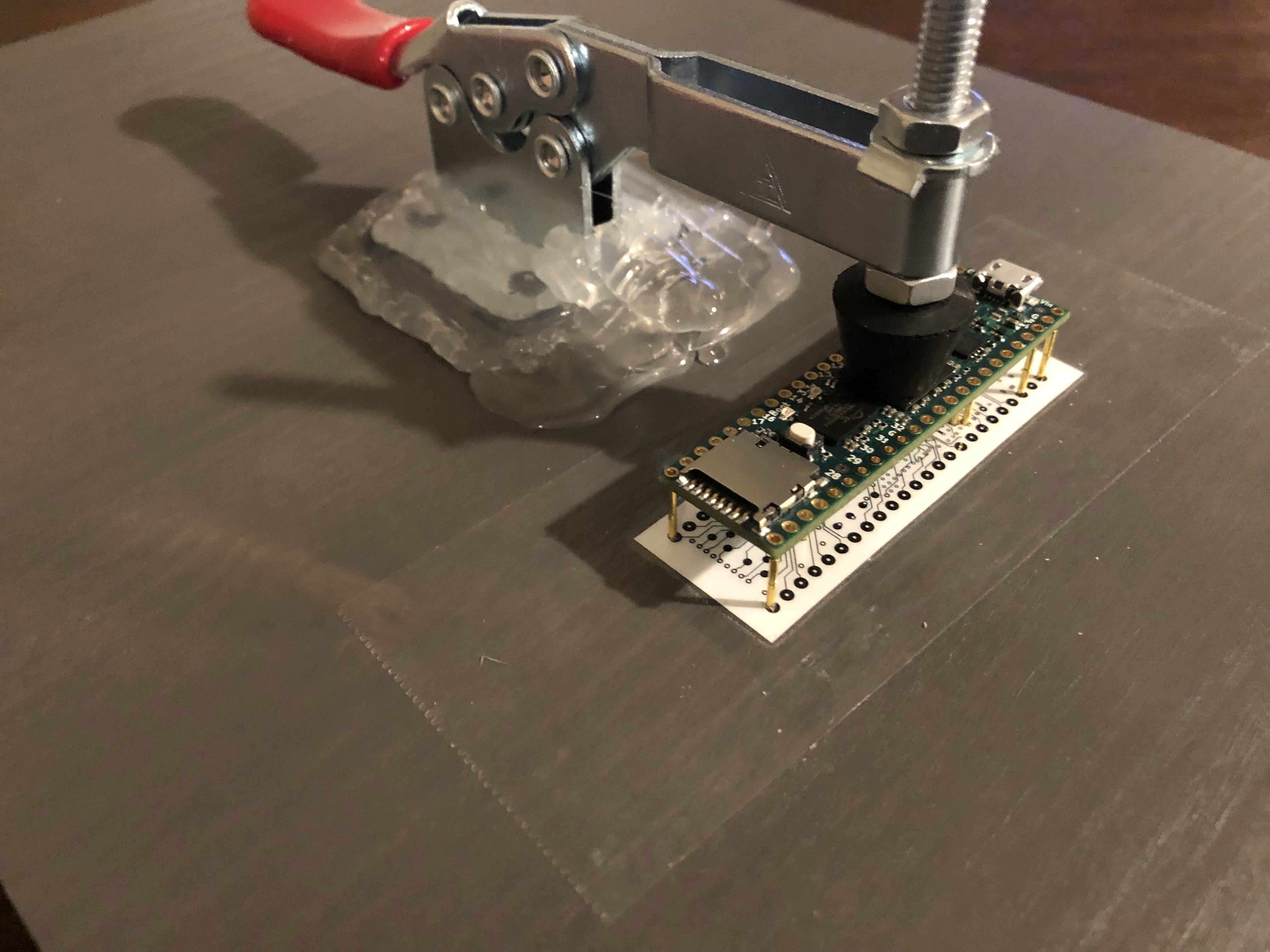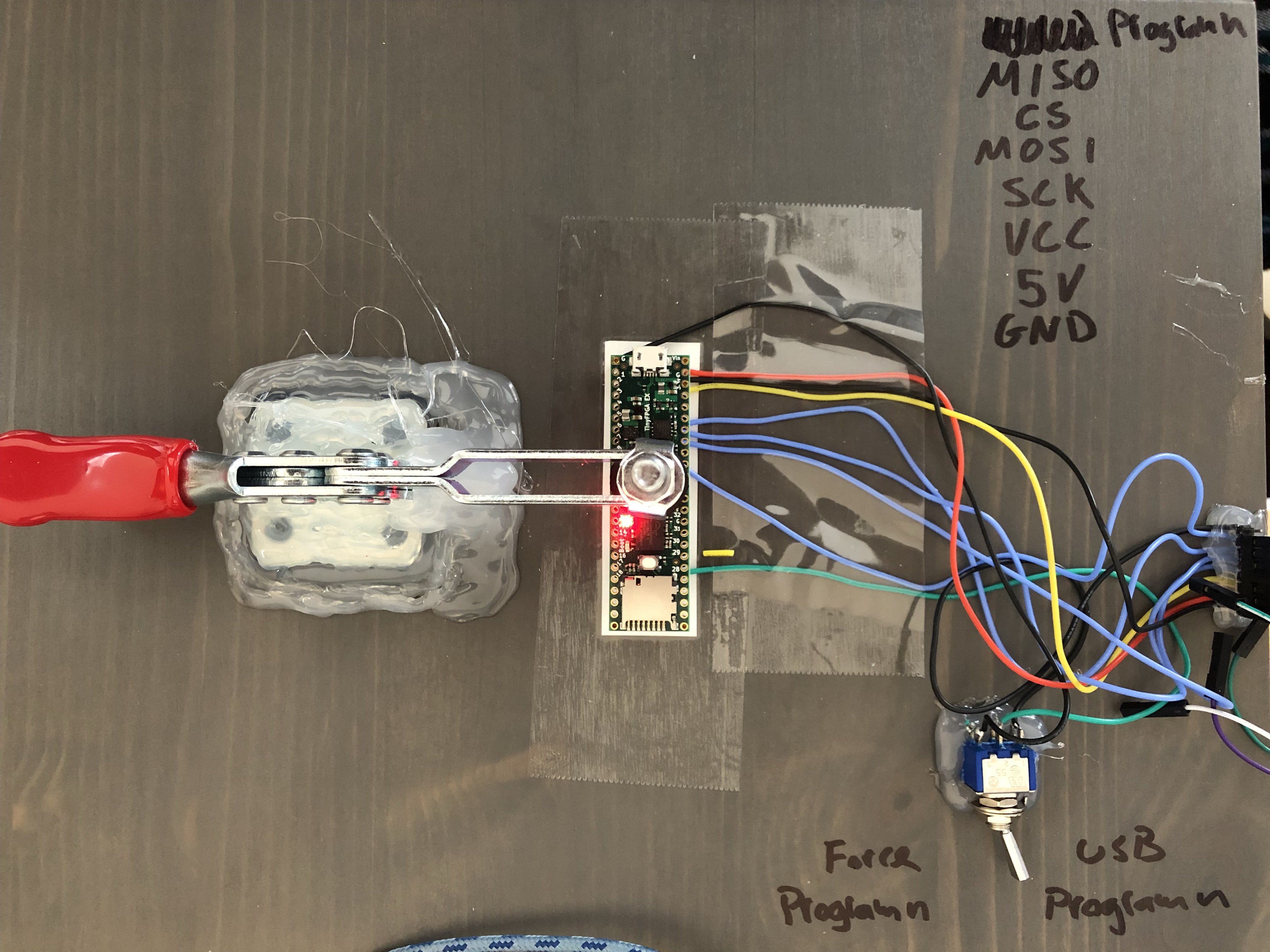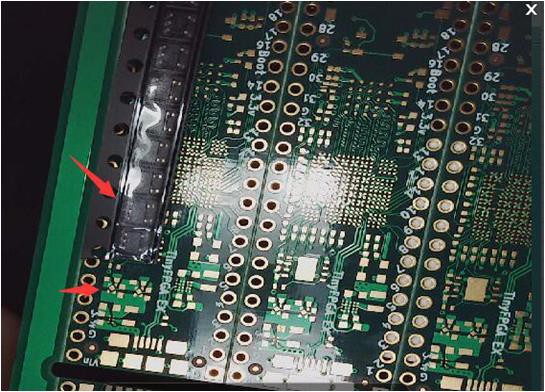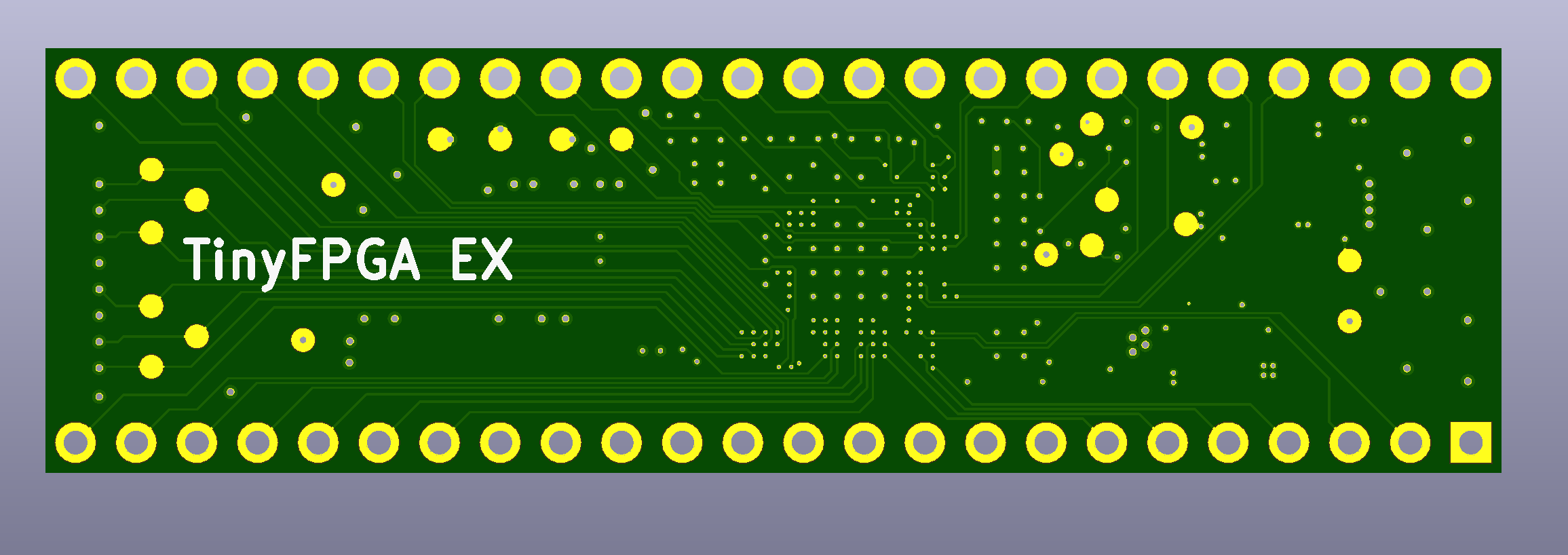-
Prototypes Arrived!
02/10/2018 at 23:11 • 6 commentsAfter months of waiting the TinyFPGA EX prototypes arrived a few days ago! I was so thrilled to finally try them out that I forgot to write a Hackaday.io post about it.
The prototype run was for one panel of 8 boards.
The first thing I did was check the bare PCBs that were sent alongside the assembled boards. It looked like there were vias missing. An inspection with my USB microscope seemed to confirm this.
![]()
I took out my multimeter to check the resistance between various pads and the external pins. Despite looking like there are missing vias, their is a reliable connection between the pads and their respective pins on the board. I'm not sure why the vias aren't visible. Maybe the plating filled in the small holes completely?
While I had the bare PCBs under the microscope I took a look at the pads for the power supplies. The two switching supplies are tiny BGA packages. The 1.1v supply can supply up to 5 amps of current! However, the inductor I choose is rated for up to 4.3 amps.
![]()
![]()
There are also a couple of linear LDO regulators that have a unique footprint. They are super tiny.
![]()
We can see that the PCBs very good quality considering the tiny size of the components and traces. Afterwards I wanted to take a look at the power supplies as assembled on the board.
![]()
Grey surface mount passive in the corner is the inductor for the switching power supply in the center. The brown components are the input and output capacitors.
![]()
The two switching supplies appear to be assembled properly and the footprints are good.
![]()
The linear LDOs are each capable of sourcing 300mA of current. They are used for the HyberRAM and the VCCAUX of the FPGA. After inspecting various components I broke out a few boards to start the process of bringing up and debugging a new FPGA board.
Before powering the board on, I wanted to make sure I wasn't going to let out the magic smoke. I measured the resistance between the ground and various supply pins. They were all high enough resistance that dangerous shorts were very unlikely. I was confident enough to apply Vin.
It worked! Well, at least the 3.3v switching power supply worked well enough to light up the 3.3v power indicator LED. I checked voltage levels of all the power rails and they were spot on. Another good sign. Next step is to see if the FPGA itself is functional. To do this I would want to connect the JTAG interface to the Lattice programming cable. The JTAG test points are on the bottom of the board and I didn't have a test-jig setup yet so I would need to solder some cables to the test points.
In addition to the JTAG port, the flash SPI interface is also on the bottom. I connected headers to both of these ports so I could spy on the configuration sequence. Running a simple ID code read on the Diamond Programmer application I got a sign of life from the FPGA!
This is a very good sign. The basic functionality of the FPGA is working. I discovered I could also read out the status register from the FPGA.
The status register reported an error. After reading the Lattice documentation I decoded the message. It translates into the following English: "I couldn't load a configuration from SPI flash. The data stored there didn't have a valid preamble." Very cool. The ECP5 FPGA can be configured in multiple different ways. I had setup some pull-up and pull-down resistors in a few pins to tell it to pull its configuration from flash. It appears to be working! Now I needed to load a valid bitstream onto the SPI flash. To do this, I wanted to use my USB bootloader from the TinyFPGA B2 project. This means I would need to port the bootloader over.
It was actually a lot easier than I expected. The FPGA programmed over JTAG just fine and bootloader was visible and functional over USB right away.
The ECP5 FPGAs do have a few oddities that tripped me up. The bootloader needs to use the SPI pins to program the SPI flash. Lattice Diamond wasn't letting me use the SPI CLK pin for a user IO. That was very odd. For a moment I thought I would have to connect another pin to the SPI CLK. Going over the documentation for the umpteenth time I discovered there is a special primitive I could use to drive the SPI CLK from user logic. This is exactly what I wanted. Except it didn't work. More debugging. Some head banging. More debugging. Ah-ha! I looked up the RTL graphical representation from the Synplify synthesis tool and I had some combinatorial loops feeding into the user SPI CLK mux. Once these two loops were gone the flash was able to be programmed over the USB bootloader.
Would it boot? It didn't take long to find out. I unplugged the board to ensure the volatile config RAM was cleared and plugged it back in. Nothing. Wait...the bootloader LED is flashing! The ECP5 FPGA is much larger than the iCE40 FPGA I had been used to in the B2 and BX boards. It had a lot more data to transfer, and the bitstream was configured for the default 2MHz clock. It was easy enough to increase this to 38MHz and now the boot speed is imperceptible to the human eye.
You might notice the blue bodge wire attached to the reset button. Unlike the iCE40 FPGAs, the ECP5 FPGAs do not support a WARMBOOT primitive. This means that the user logic running in the ECP5 FPGA cannot directly tell the FPGA to reconfigure itself to a specific image. I really should have known this before I ordered the prototypes. It was a big oversight.
Instead of the WARMBOOT primitive, the multiboot bitstream image itself contained the information on which image to load next. To trigger a reconfiguration to the next image, either the PROGRAMN pin on the FPGA has to be pulled low, or a REFRESH command has to be sent on the external JTAG port. It was fairly simple to connect a bodge wire from a user IO pin to the PROGRAMN pin. Now the bootloader is 100% functional on the TinyFPGA EX prototypes.
I was eager to bring all of my prototypes up to par so I built a simple programming jig to program the SPI flash directly.
The jig was very simple. Just enough pogo pins to keep the board stable while clamped and program the flash. I broke out the rest of the prototypes and filed their rough edges.
All the prototypes were programmed with the bootloader.
The next step for these boards is to implement some fun designs on them. Something that takes advantage of the HyperRAM and micro SD card slot would be nice.
Follow the project for updates including the eventual details on ordering a production unit.
-
Always check your BOM...
01/11/2018 at 08:27 • 0 commentsThe E-Series prototype boards were going to assembly at my PCBA house when they discovered a problem. The linear voltage regulators did not fit on the footprint. After having a minor heart-attack I looked at the picture they sent and understood what happened. I had given them the wrong part numbers. They were off by one letter. I gave them part numbers for a different physical package. Thanks to the picture they sent it was easy to remedy. Always double-check your BOM before manufacture. This was not a big deal because it's just 16 components and they are very cheap. But it did delay assembly another week while they source the correct parts.
![]()
On the bright side it was nice to see a picture of the prototype PCBs :)
-
Still waiting for prototypes...
12/25/2017 at 07:16 • 0 commentsI'm still waiting on the prototype boards! Currently I'm waiting on getting the ECP5 parts. This should happen soon. In the mean-time I'll need to make a pogo-pin test rig and general-purpose testbench for it.
-
Prototypes Ordered
11/21/2017 at 07:08 • 0 commentsI sent the gerbers and associated files to PCBWay for manufacture and assembly. The BGA package on the ECP5 FPGA I'm using requires 0.15mm via drills and 4 copper layers to route out all the necessary IOs, grounds, and power rails. This means it's an advanced PCB process that has much more expensive fixed costs. I've reviewed the board layout and schematic several times. It should work. I think. It will be very interesting to see what sort of issues pop up. When I do get the prototypes back in a month (if I'm lucky it will be that fast!), I'll have the following things to checkout in roughly this order:
- 3.3v switching regulator
- 1.1v switching regulator
- 2.5v LDO regulator
- 1.8v LDO regulator
- FPGA JTAG
- I should be able to hook it up to the lattice programming cable and get some signs of life
- SPI Flash
- I should be able to read and write the SPI flash using the testpoints
- FPGA/flash connection
- I should be able to make a simple LED blinky design to make sure the FPGA can read its configuration from flash.
- 16MHz MEMs clock
- I should be able to make a design using the 16MHz clock and it should work
- USB Bootloader
- I'll be porting the #TinyFPGA B-Series USB bootloader to the ECP5 FPGA. I've included a dynamic pull-up resistor on the USB lines so I can make the connect process more reliable.
- HyperRAM!
- I'm super excited about the HyperRAM...but it will be a new challenge to develop a robust interface for the HyperRAM since it uses a unique DDR protocol called HyperBus.
There's plenty of work to do while I'm waiting for the boards. Beyond getting ready for the initial checkout of the prototype boards, I'll also be designing a pogo-pin test bed for production checkout of all TinyFPGA E-series boards. The pogo pins will contact each of the IOs as well as all of the power rails and test points on the bottom of the board to access the SD Card interface, JTAG, SPI, PROGRAMN, 1.1v, 1.8v, and 2.5v nets.
Bottom of the TinyFPGA E-series board with test pads -
A new TinyFPGA series to fill out the tiny line-up
11/18/2017 at 20:50 • 0 commentsWhen I started working on TinyFPGA I was making a simple FPGA board for myself. That simple board became the #TinyFPGA A-Series. I chose the MachXO2 for the first board because it was a very simple to use FPGA and it had a very easy to assemble QFN32 package. It was something I could reliably assemble and reflow myself in my home lab. I ended up getting it manufactured anyways. But that package made it cheap and easy for the first prototypes.
After developing the A-series, I had a desire for more. A larger FPGA and more features built-in. I also had more confidence with one project under my belt. The #TinyFPGA B-Series was a much more complicated board to develop. It uses an FPGA with a 0.4mm pitch BGA package with 81 balls. I was able to make it work very reliably with a common PCB manufacturing process so my prototypes were cheap and functional. I also was able to deliver a lot more features in a tiny package.
All of the TinyFPGA boards are selling well enough to give me confidence and now I need to refresh my stock. So I have been ordering new boards and have learned quite a bit from my original manufacturing runs.
I still want to be able to deliver more options for these tiny FPGA boards. I think I found a way. The Lattice ECP5 FPGAs have relatively low power consumption with prices way lower than comparable alternatives. That's good to know, but the best part is the package size. They have a package option that is just 10 x 10 mm and is available across the entire range of ECP5 FPGAs. This means I can develop one board and support multiple FPGA sizes.
With the ECP5 FPGA and the TinyFPGA E-Series, I think I am pushing the limit of what will work in this form factor with today's technology. The package size, number of balls on the package, power delivery requirements, and PCB manufacturing technology are all being pushed to the limit at this price point and form-factor.
Not only will these new TinyFPGA boards feature FPGAs rivaling the size of any hobbyist FPGA board, they will also include 64mbit DDR memory, 64mbit SPI flash, high-efficiency switching voltage regulators, and a micro-sd card slot in addition to all of the features on the B-series boards.
It has been quite a challenge designing this board and there are more challenges to come. The next step in bringing these to market will be getting the prototype boards back and running them through their paces. If you want to use big FPGAs in a tiny form-factor without breaking the bank, follow this project. I'll be posting updates as boards come back and development progress is made.
TinyFPGA E-Series
Tiny board with a BIG FPGA. SD card, 64mbit DDR RAM, ECP5 FPGA, 64mbit flash, and micro USB. Do more with up to 45k LUTs.
 Luke Valenty
Luke Valenty